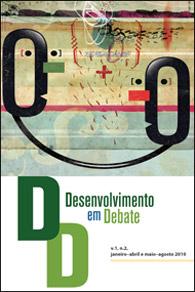Políticas Públicas, atores e regras: uma perspectiva neoinstitucionalista da dinâmica do Programa Nacional de Produção e Uso de Biodiesel
Mots-clés :
Políticas Públicas, Institucionalismo, BiocombustíveisRésumé
O artigo esboça um quadro de análise do processo de formulação de políticas que privilegia a dinâmica da relação entre instituições e comportamentos dos atores. Para tanto, recorre a aportes teóricos desenvolvidos por autores neoinstitucionalistas. A partir dessa estrutura analítica, proporciona-se uma análise do processo de formulação do Programa Nacional de Produção e Uso de Biodiesel. A análise dessa política tem por objetivo de mostrar como uma abordagem neoinstitucionalista auxilia a apreensão dos elementos e das relações entre os elementos pertinentes à compreensão da ação pública, de seus resultados e de sua dinâmica.
Références
ALLISON G. (1971) Essence of decision: explaining the Cuban Missile Crisis, Little Brown
AKERLOF, G. & SHILLER, R. (2009) Animal Spirit, Princeton University Press
BARDHAN, P. (2005) Scarcity, Conflicts and Cooperation: Essays in the Political and Institutional Economics of Development, MIT Press
BENNETT, C. J. & HOWLETT, M. (1992), “The lessons of learning: reconciling theories of policy learning and policy change”. Policy Sciences, 25 (3): 275-294.
CRAWFORD, S. &, OSTROM, E., (1995) “A grammar of institutions”, The American Political Science Review 89, 582–600.
ELSTER, J. (2009) Ulisses liberto: estudos sobre racionalidade, pré-compromisso e restrições. São Paulo: Editora Unesp.
____ (2010) L´ irrationalité: Traité critique de l´ homme économique, Seuil
FESTINGER, L. (1957) A Theory of Cognitive Dissonance. Stanford University Press
HECLO, H. (1974) Modern Social Politics in Britain and Sweden: From Relief to Income Maintenance. New Haven, Conn: Yale University Press.
HIRSCHMAN, A.O. (1963) Journey toward Progress, The Twentieth Century Fund (1984) De la economia a la política y mas allá, Fondo de Cultura Económica
KAHNEMAN, D., & TVERSKY, A. (1984) “Choices, values, and frames”. American Psychologist
:341-50
KNIGHT J. (1992) Institutions and Social Conflict. Cambridge Univ. Press
MAYNTZ, R. & SCHARPF, F. (2001) “L´ institutionnalisme centre sur les acteurs”, Politix, 14(55); 95-123
NELSON, B. (1996) “Public Policy and administration: an overview”, GOODIN R.E.& KLINGEMANN,
H. D. (org.) A New Handbook of Political Science, Oxford University Press, 551-590
OSTROM, E. (2005) Understanding Institutional Diversity, Princeton University Press
(1990), Governing the Commons: The Evolution of Institutions for Collective Action, New York: Cambridge University Press.
____ (1998), “A Behavioral Approach to the Rational Choice Theory of Collective Action,” 92(1) American Political Science Review, 1–22
____ (2003) “Toward a Behavioral Theory Linking Trust, Reciprocity and Reputation.” In, Trust and Reciprocity: Interdisciplinary Lessons From Experimental Research, edited by James Walker. New York: Russell Sage Foundation.
____ (2000) “Collective action and the evolution of social norms”. J. Econ. Perspect. 14, 137–158
REDE BRASILEIRA PELA INTEGRAÇÃO DOS POVOS (REBRIP). FEDERAÇÃO DE ÓRGÃOS DE
ASSISTÊNCIA SOCIAL E EDUCACIONAL (FASE). 2008 Agrocombustíveis e a agricultura familiar e camponesa: subsídios ao debate. Rio de Janeiro: REBRIP/FASE
SABATIER, P. (2007) Theories of the policy process. WestView Press
SCHARPF, F. (1997) Games Real Actors Play. Westview Press
SCHMID, A.A. (2005), Conflict and Cooperation: Institutional and Behavioral Economics, Blackwell, Malden, MA.
SIMON, H. A. (1955) “A behavioral model of rational choice”, Quarterly Journal of Economics 69: 99-118.
THALER R. & SUSTEIN C. (2008) Nudge, Yale University Press
TSEBELIS, G. (1998) Jogos Ocultos, Editora da USP
____ (2002) Veto Players, Russell Sage Foundation
TVERSKY A. & SHAFIR E. (2004) Preference, Belief and Similarity: Select writings Amos Tversky, MIT Press


